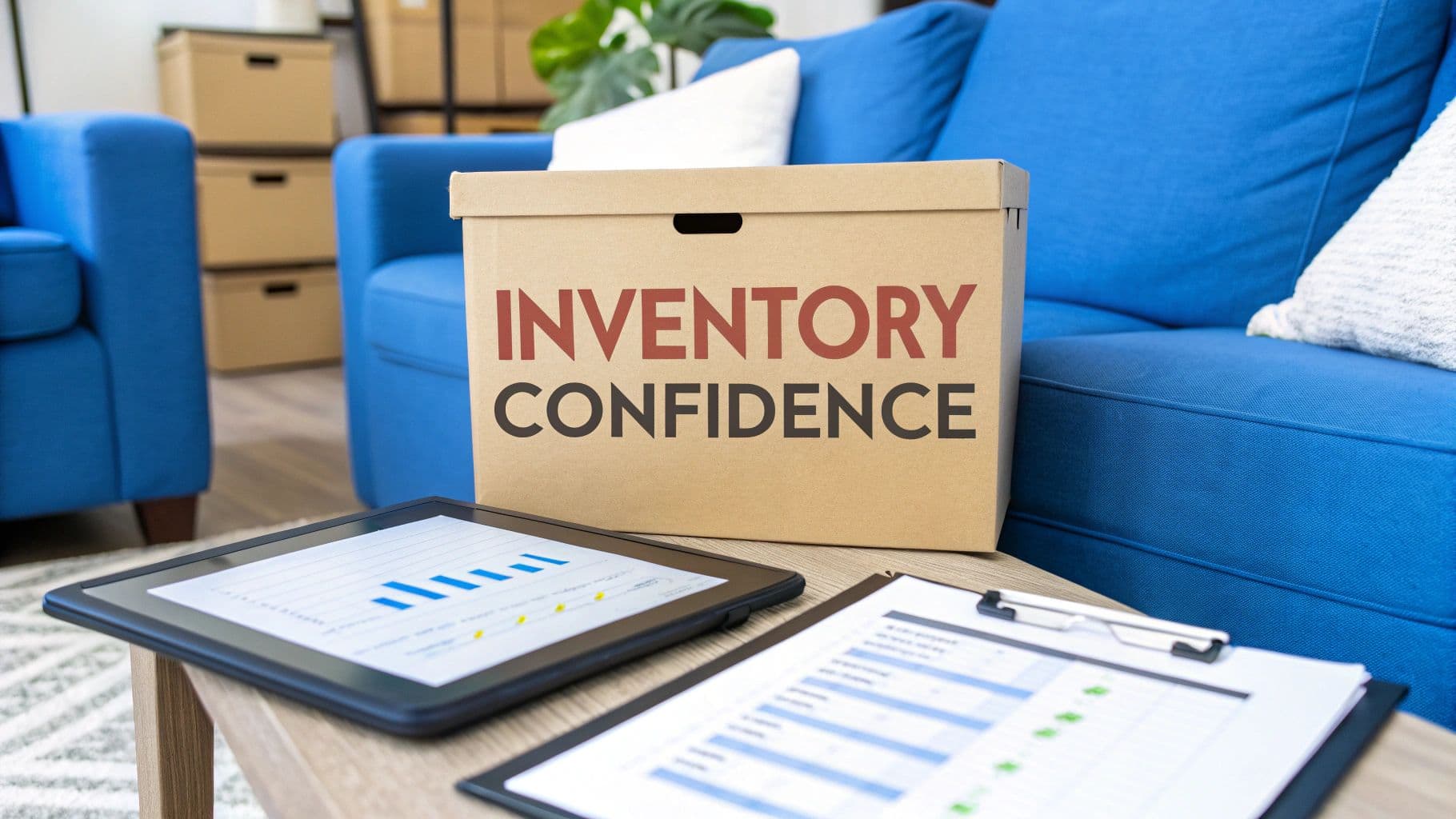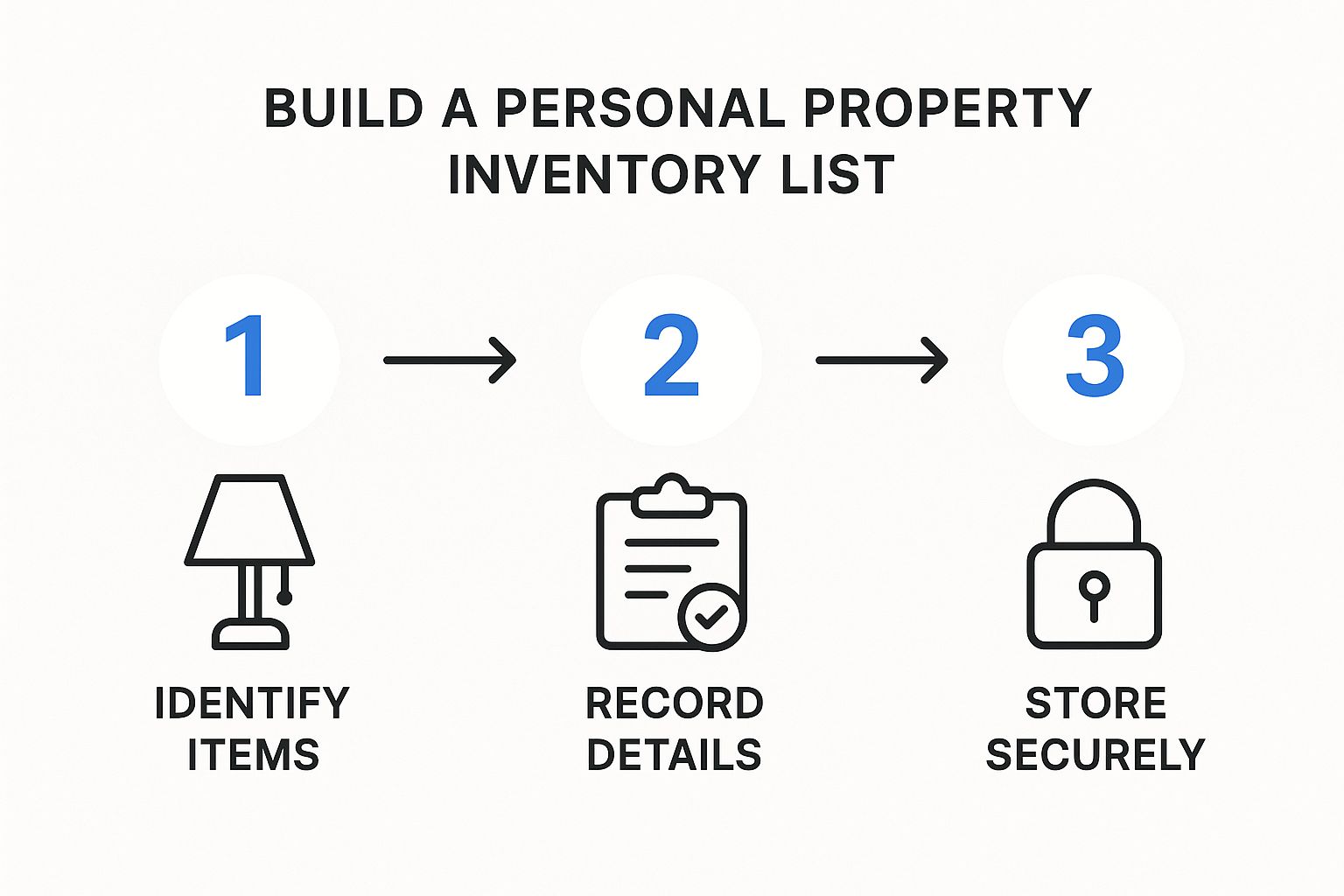Build Your Personal Property Inventory List with Confidence

Let’s be honest, the thought of creating a complete inventory of everything you own sounds like a massive, tedious chore. Most people put it off, thinking it’s something only the hyper-organized would ever do.
But what if I told you it might be the single most important document you create for your financial well-being? This isn't just about making a list. It’s about creating a definitive record of everything you’ve worked so hard to acquire.
Why a Home Inventory Is More Than Just a List

I’m not exaggerating. When a crisis hits—a fire, a flood, a burglary—a detailed personal property inventory is your best friend. Without one, you’re left trying to recall every single item from memory, all while dealing with immense stress. Trust me, it's a nearly impossible task that often leads to huge financial losses when you file an insurance claim.
The Real-World Impact on Insurance Claims
After a disaster, your insurance company is going to ask for an exhaustive list of every single thing you lost before they pay out. I’ve seen it happen time and again: this process is so mentally draining that many people just give up. They end up accepting a fraction of what they're actually owed.
Insurers might even offer a quick settlement—say, 80% of your coverage—if you agree to skip the itemization. It’s tempting, but you're automatically leaving 20% of your policy's value on the table simply because you don’t have the proof. A prepared inventory list gives you the power to claim the full amount you deserve.
A detailed inventory fundamentally changes the dynamic with your insurance provider. It shifts the burden of proof from your stressed-out memory to a factual document, putting you in a position of strength during negotiations.
This proactive step shows you’re prepared and provides undeniable evidence. The result? A much faster claims process and a fair settlement.
A home inventory is a versatile tool with benefits that go far beyond just insurance. Here’s a quick look at where it truly proves its worth.
Primary Uses for a Personal Property Inventory List
| Scenario | How Your Inventory List Helps |
|---|---|
| Insurance Claims | Provides indisputable proof of ownership and value, speeding up the process and ensuring a full, fair settlement. |
| Estate Planning | Creates a clear, organized record for heirs, simplifying asset distribution and preventing family disputes. |
| Moving or Downsizing | Helps you make informed decisions about what to keep, sell, or donate by showing you exactly what you own. |
| Financial Planning | Gives you a more accurate picture of your net worth by calculating the total value of your personal assets. |
From protecting your family’s legacy to simply making a move less stressful, this single document serves you at multiple stages of life.
Beyond Disaster Recovery
The importance of this documentation is only growing. The U.S. residential real estate market was recently valued at a staggering $106.7 trillion—a figure that grew by nearly 49% in just five years and is projected to keep climbing. As your home’s value increases, so does the value of everything inside it.
This makes having an accurate inventory more critical than ever for your financial and legal preparedness. You can explore more about real estate trends and how they affect property management.
Ultimately, creating this list is an investment in your own peace of mind. It’s the comfort of knowing that, no matter what happens, you have a detailed, actionable record of your life’s possessions ready to protect you and your family.
Finding the Right Inventory Method for You
So, you’re ready to create a personal property inventory. Great! The first, and arguably most important, decision you'll make is how you're going to do it. The world's most detailed system is worthless if it’s so complicated you abandon it halfway through.
Let's cut through the noise. There are really three main ways to tackle this. Your choice will likely come down to your comfort with technology, the sheer amount of stuff you own, and what you’re willing to spend. There's no single "best" way—only the best way for you.
No matter which path you take, the core job is the same. This image breaks down that universal workflow.

As you can see, it always boils down to a few key actions: identifying your items, recording the important details, and storing that information somewhere safe and accessible. The method you choose is just the tool that helps you get it done.
Comparing Home Inventory Methods
To make the choice easier, I've put together a quick comparison of the most common approaches. Think about your own habits and needs as you review the pros and cons of each.
| Method | Best For | Pros | Cons |
|---|---|---|---|
| Classic Spreadsheet | DIYers who want total control and have a basic comfort level with programs like Excel or Google Sheets. | • Inexpensive (usually free) • Fully customizable columns • Widely accessible | • Can be time-consuming • Entirely manual data entry • You're responsible for backups |
| Home Inventory App | Tech-savvy individuals who value speed, convenience, and mobile access for their personal property inventory list. | • Fast and efficient • Features like barcode scanning • Automatic cloud backup | • Usually requires a subscription • May have less customization • Learning curve for new software |
| Professional Service | Those with large estates, high-value collections, or anyone short on time who wants a guaranteed, thorough result. | • Saves significant time/effort • Highly detailed and accurate • Third-party verification | • Most expensive option • Less personal control • Scheduling can take time |
Ultimately, the best method is the one you will actually use. An incomplete list is only marginally better than no list at all, so picking the path of least resistance is the smartest move you can make.
The Classic Spreadsheet Approach
For anyone who appreciates a no-frills, straightforward system, you can’t go wrong with a simple spreadsheet. Using a program like Microsoft Excel or Google Sheets puts you in the driver’s seat. You decide what information to track, how to format it, and how deep you want to go.
Most of us already have this software, making it incredibly accessible. You can easily set up columns for an item’s description, brand, serial number, purchase date, and value. It’s also simple to add links to online receipts or store digital photos in a corresponding folder.
The flip side? It’s all on you. A spreadsheet requires discipline to keep updated and can get clunky if you have a massive amount of property. You are also 100% responsible for backing it up.
Modern Home Inventory Apps
If your phone is practically attached to your hand, a dedicated home inventory app might be your perfect match. These apps are purpose-built for the job, with smart features a spreadsheet just can't offer. Think barcode scanning that auto-fills product details or snapping a photo that instantly uploads to the right item entry.
Many of these apps also include cloud storage, which immediately solves the critical off-site backup problem. Some popular options to check out include:
- Sortly: Fantastic for visual people, as it organizes items into folders by room or category.
- Encircle: A powerful tool often used by insurance pros, but its robust reporting is available to homeowners, too.
- MyStuff2 Pro: A highly customizable database perfect for serious collectors or anyone with a massive, complex inventory.
Most come with a small subscription fee, but the convenience and peace of mind can be well worth it.
The real game-changer with an app is speed. A task that could take hours with a spreadsheet—like adding photos for 50 different items—can be done in minutes. That efficiency boost makes it far more likely you'll see the project through to the end.
Professional Inventory Services
What if you have a large estate, valuable collections, or simply zero time to spare? In that case, hiring a professional inventory service is a perfectly valid choice. These companies send trained specialists to your home to do all the heavy lifting. They handle the photography, research the details, and enter all the data, delivering a complete, polished inventory.
This is certainly the most expensive route, but it guarantees a detailed and accurate result with almost no effort on your part. It's an excellent option for complex estate settlements or for homeowners who need a certified list for high-value insurance policies.
This approach is also a smart first step before a major life event, like a big move. Having a professional baseline of everything you own is invaluable, and you can learn more about the benefits of decluttering before moving in our other guide.
A Practical Room-By-Room Documentation Strategy

Let's be honest. The biggest thing stopping most people from starting a personal property inventory list isn't how hard it is—it's just plain overwhelming. Looking at an entire house full of stuff can cause instant analysis paralysis. So, forget the aimless wandering. We're going to use a simple, systematic approach that turns one huge project into a series of small, easy wins.
The secret is all in the structure. When you break your home down into logical zones, you give yourself a clear roadmap. This method keeps you on track and, more importantly, makes sure you don't miss a thing.
The Clockwise Method: Your Blueprint for Success
Trying to remember everything at once is a recipe for failure. The most effective strategy I’ve seen over the years is beautifully simple: the clockwise method.
Just pick a room to start—the living room is always a good candidate. Stand in the main doorway, look to your left, and start documenting everything along that first wall. From there, just work your way clockwise around the room, tackling one item or group of items at a time.
This simple rule of movement keeps you focused. It creates a natural flow and stops you from bouncing all over the place, which is exactly how things get missed. Once you’ve made a full circle, that room is done. Move on to the next one and do it all over again.
The real power of the clockwise method is psychological. It transforms an abstract goal ("inventory the house") into a concrete, physical task ("inventory this wall, then the next"). This small shift makes the entire process feel more achievable.
By following this path, you'll methodically cover every single corner, from the big-ticket electronics to the small decorative lamp you forgot was even there.
What to Capture for Each Item
As you move through the room, your goal is to grab the key details that prove an item’s value and existence. Consistency is your best friend here. For every significant item, make sure you record this info:
- Item Description: Be specific. Not just "TV," but "Samsung 65-inch QLED 4K Smart TV."
- Brand and Model Number: Essential for electronics, appliances, and major tools.
- Serial Number: For high-value items, this is the ultimate proof of ownership. Don't skip it.
- Purchase Date and Price: If you have the receipt, great. If not, your best estimate is perfectly fine.
- Estimated Current Value: Think "actual cash value"—what it would cost to replace today, minus depreciation.
- Photos and Videos: Take clear shots from a few different angles. For electronics, get a close-up of that serial number tag.
An insurance adjuster can't argue with a clear photo of a serial number. This is the level of detail that makes your inventory list a genuinely powerful tool if you ever need to make a claim.
Grouping Low-Value Items Efficiently
Look, you don't need to list every single fork and spoon. That's a fast track to insanity and it’s completely unnecessary. For low-value things that you have a lot of, grouping is the smart way to go.
Think about your kitchen drawers or your bookshelves. Instead of listing every paperback, you can create a single entry that covers the whole lot.
Here’s an example of grouping:
- Category: Kitchen Utensils
- Description: Assorted cooking utensils including spatulas, ladles, whisks, and tongs.
- Quantity: Approximately 40 pieces.
- Estimated Value: $150
- Photo: Just snap a picture of the open drawer with everything visible.
You can apply this same logic to just about any collection of similar, low-cost items.
| Category to Group | Example Description |
|---|---|
| Books | Approximately 100 paperback fiction and non-fiction books. |
| Clothing | Collection of men's casual shirts, various brands. |
| Dishware | 12-person set of ceramic plates, bowls, and mugs. |
| Tools | Assorted hand tools (hammers, screwdrivers, wrenches). |
This strategy will save you a massive amount of time but still gives an adjuster what they need to assign a fair value to the contents of a closet or cabinet.
A Pro Tip: Video Narration
Want to get through the initial documentation phase even faster? Use your phone's video camera. Hit record as you enter a room and start your clockwise sweep.
As you film, just talk about what you're seeing. For instance: "Here is our Sony 75-inch X90J television, serial number S01-1234567, bought in November 2022 for about $1,800." Then, pan down. "And below it is the Sonos Arc soundbar, bought at the same time."
This captures visual proof and all the key details at once. You can always go back later and plug that information into your spreadsheet or app when you have more time. It’s a fantastic way to create a raw, comprehensive record without getting bogged down in typing, ensuring you nail the most important part of building your personal property inventory list.
Handling Your High-Value Items and Essential Paperwork

While it's smart to group your everyday kitchen gear, your most prized possessions need a completely different level of attention. We're talking about the real treasures: fine jewelry, original art, antiques, or that rare collection you’ve spent years building. For these, a simple line on your personal property inventory list is nowhere near enough.
This is the point where your inventory stops being just a list and becomes a serious financial and legal asset. Documenting these pieces the right way gives you undeniable proof of value. That's critical for getting the right insurance coverage and absolutely essential for any future sale or estate planning. Trust me, skipping this step can be a costly mistake down the road.
When to Call in a Professional Appraiser
So, how do you know when an item needs this special treatment? My personal rule of thumb is pretty simple: if you can't easily find its value online or if it could be worth more than $1,500, it’s time to think about a professional appraisal. This is especially true for anything you've inherited where you don't have a clue about the original price or current market value.
An appraiser delivers a certified, legally recognized valuation. This isn't just an educated guess; it's an expert assessment your insurance company will actually respect.
Items that almost always need an appraisal:
- Fine Jewelry and Watches: Any piece with significant diamonds, gemstones, or precious metals.
- Original Art: Paintings, sculptures, or signed prints by recognized artists.
- Antiques: Furniture, clocks, or decor that is verifiably over 100 years old.
- Collectibles: Rare coins, stamps, first-edition books, or major sports memorabilia collections.
Once you have that appraisal report, don't just shove it in a drawer. Scan it immediately and attach the digital file directly to that item’s entry in your inventory app or spreadsheet. Now you have a self-contained, indisputable record.
An appraisal turns an item's value from an "estimate" into a "fact." For your most cherished possessions, that distinction is everything. It removes all guesswork for insurers and ensures you're compensated for the item's true worth, not just a generic replacement cost.
Build a Digital Vault for Your Critical Documents
Your inventory doesn't end with physical things. Your most important paperwork is just as valuable—and often a nightmare to replace. Just think about the documents you'd be desperate for after a house fire or during a sudden medical emergency. These papers are the legal foundation of your life.
The goal here is to create a digital vault—a secure, easy-to-access collection of your most vital records. Start by scanning each document to create a crisp, clear PDF.
Your digital vault should absolutely contain:
- Estate Planning Documents: Your will, any trusts, and powers of attorney.
- Property Records: The deed to your home, vehicle titles, and recent property tax statements.
- Identification: Passports, driver's licenses, Social Security cards, and birth certificates for everyone in your household.
- Financial and Legal Papers: Major loan agreements, business formation documents, and your last few tax returns.
Name each file something obvious (like "Jane_Doe_Passport_2024.pdf") and sort them into folders in your secure cloud storage. This digital backup becomes your lifeline when the physical copies are gone or out of reach.
Why This Matters in the Current Market
The need for this kind of detailed record-keeping is even more pronounced given today's housing market. With a tight supply of homes for sale, many people are staying in their homes longer, making the protection of their property more important than ever. A detailed personal property inventory list is crucial not just for insurance claims, but for accurately assessing your home's total value if you eventually decide to sell. To see how these larger trends can affect your decisions, you can get more insights on the U.S. housing market outlook from JPMorgan.
When you combine meticulously documented valuables with a secure digital vault of your essential paperwork, you create a truly powerful record. You're not just protecting your stuff—you're protecting your entire legal and financial identity, making sure you’re ready for whatever comes your way.
How to Store and Maintain Your Inventory Safely
Creating your personal property inventory list is a massive accomplishment, but the job isn’t quite done yet. An inventory is completely useless if it’s destroyed in the very disaster you created it to prepare for.
Honestly, one of the biggest mistakes you can make is just saving the file to your computer's desktop and calling it a day. If a fire or flood strikes, that list will disappear right along with everything else. To really protect this vital document, you need a smart, redundant storage strategy.
Think of your inventory as the key to your financial recovery; you need to make sure that key is always safe and accessible, no matter what happens to your home.
The 3-2-1 Backup Rule for Inventories
In the world of data protection, experts swear by the 3-2-1 backup rule. It’s a simple but powerful concept that virtually guarantees your information will survive almost any catastrophe. We can easily adapt it for your home inventory.
Here’s the breakdown:
- Have three total copies of your inventory.
- On two different types of storage media.
- With one of those copies stored securely off-site.
This might sound overly technical, but it's surprisingly easy to put into practice. For instance, your first copy is the working file on your laptop (media type one). Your second copy could be on a physical USB flash drive (media type two). The third, off-site copy? That’s in a secure cloud service. Just like that, you've fulfilled the rule.
Think of it like this: you have your house key, you give a spare to a trusted neighbor, and you have a photo of the key in your phone. This redundancy ensures you can always get back in. The 3-2-1 rule does the same for your financial assets.
Practical and Secure Storage Options
Now let's talk about where to actually store these copies. The goal is to mix digital and physical options, as well as local and remote locations, to build a truly resilient system. You don't want to put all your eggs in one basket.
Secure Cloud Storage This is hands-down the easiest and most effective off-site solution. Services like Google Drive or Dropbox automatically sync your files. When you update the inventory on your computer, the cloud version updates, too. This is your primary defense against a total loss of your home and everything in it.
Physical Off-Site Storage For your second storage type, think about a physical copy kept somewhere else. Good options include:
- A Safe Deposit Box: Perfect for stashing a USB drive or even a printed copy alongside your other critical documents.
- A Trusted Family Member: Give a copy on a password-protected flash drive to a relative or close friend who lives in another town.
- Your Workplace: If company policy allows, keeping a secure copy in a locked desk drawer can be a simple off-site solution.
Globally, commercial real estate trends show that supply shortages are getting worse for many property types, which increases the value and complexity of assets held within them. This environment raises the stakes for precisely documenting personal property, making detailed inventory lists critical for effective asset management, not just insurance. To better understand these market forces, you can explore the global real estate outlook on JLL.com.
Make Maintenance a Simple Habit
Your personal property inventory list is a living document, not a project you do once and forget about. For it to be effective when you need it most, it has to reflect your current possessions. An outdated list can be almost as problematic as having no list at all.
Set a simple, recurring reminder in your calendar—maybe for the start of each year—to do an inventory review. Sit down for an hour and go through your list. Remove items you've sold or discarded, and add any big-ticket purchases from the past year, like new furniture, electronics, or appliances. This is also the perfect time to snap new photos of items showing significant wear and tear.
Beyond that, get into the habit of making quick updates after major life events or significant purchases. Just bought a new high-end laptop or received a piece of valuable jewelry? Spend five minutes adding it to your inventory right away. This approach is much less daunting than trying to remember everything a year from now. This regular upkeep ensures your list is always ready to go, whether for an insurance claim or as part of a future online estate sale.
Common Questions About Home Inventories
As you start the journey of documenting everything you own, it's completely normal for a few practical questions to pop up. Making a personal property inventory list is pretty straightforward on the surface, but the real-world details can sometimes feel a bit fuzzy. Let's clear up some of the most common hang-ups with direct, experienced answers to help you get the job done right.
These are the kinds of questions that tend to stop people in their tracks. Getting them answered now will give you the confidence to build an inventory that actually works when you need it most.
How Detailed Do I Really Need to Be?
This is the big one, and the answer always comes down to value. For your high-value items—anything you'd hesitate to replace out-of-pocket, say over $500—you need to be as specific as possible. Think brand, model, serial number, when and where you bought it, how much you paid, and several photos from different angles. This level of detail is non-negotiable for electronics, quality furniture, jewelry, and major appliances.
For the small stuff, you can absolutely group things together. For example, your kitchen utensils or paperback book collection don't need individual entries. Something like, "Assorted kitchen utensils, approx. 50 items, estimated value $250," along with a quick photo of the drawer they're in, is perfectly fine.
A great rule of thumb is to ask yourself: "If this item vanished, could I prove its existence and value with what I've written down?" If the answer is a confident yes, you've done enough.
What Is the Best Way to Determine Item Value?
For most of your belongings, you’ll be using what the insurance world calls "actual cash value" (ACV). It sounds complicated, but it's really just what the item would cost to replace today, minus depreciation for its age and wear. A quick search for similar used items on sites like eBay is a fantastic way to get a realistic number. And for anything you bought recently, the original receipt is your golden ticket.
But for your truly valuable assets—we’re talking fine art, antiques, collectibles, or that heirloom jewelry—this method just won't cut it. For these, getting a professional appraisal is the only way to go. An appraisal gives you a certified valuation that an insurance adjuster can't really argue with. Make sure you scan and attach a digital copy of that appraisal right into the item's entry in your inventory.
Should I Share My Inventory with My Insurance Agent?
It's a smart move to have a chat with your insurance agent once a year to review your homeowners or renters policy anyway. This is the perfect time to bring up your finished inventory.
By sharing the total estimated value of your property, you and your agent can quickly see if your coverage limits are still adequate. You’d be surprised how many people discover they're underinsured after doing this exercise.
You don’t need to send them the entire spreadsheet unless they ask for it after a claim. Just letting them know you have a comprehensive, up-to-date personal property inventory list is powerful. It shows you’re a prepared and responsible policyholder, which can make things go a lot smoother if you ever need to file a claim.
This kind of documentation is also a lifesaver during major life events, not just for insurance. For instance, an executor managing an estate will find a detailed list invaluable. If you’re curious about that side of things, our guide on how to start an estate sale business provides more insight into valuing and liquidating assets.